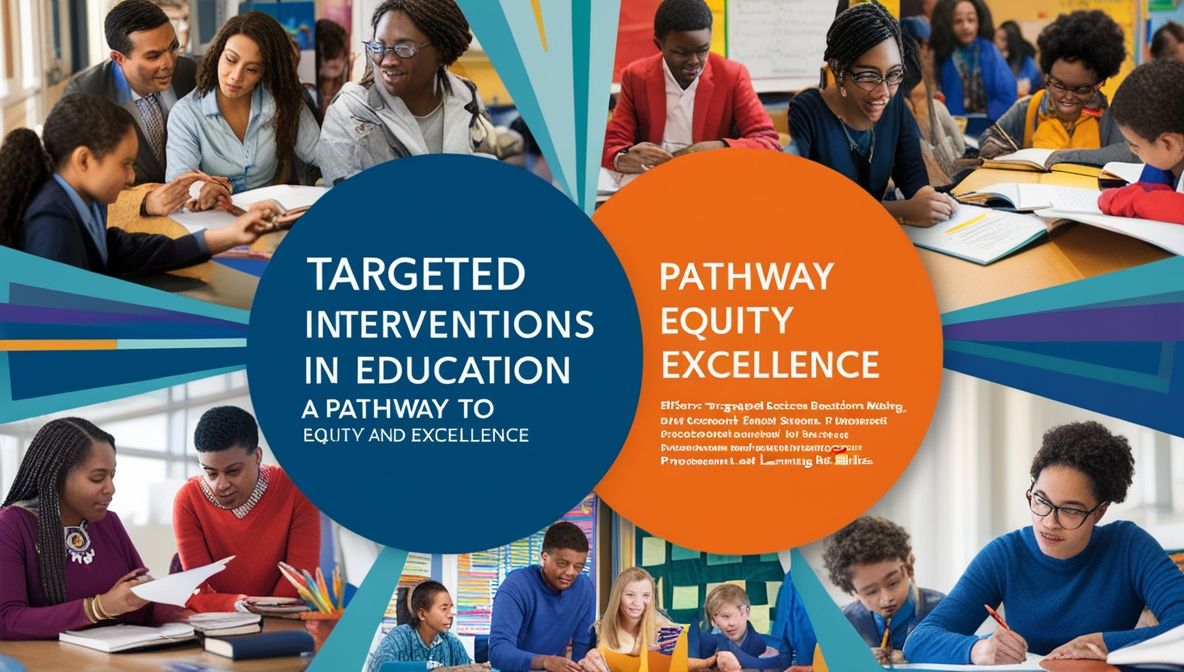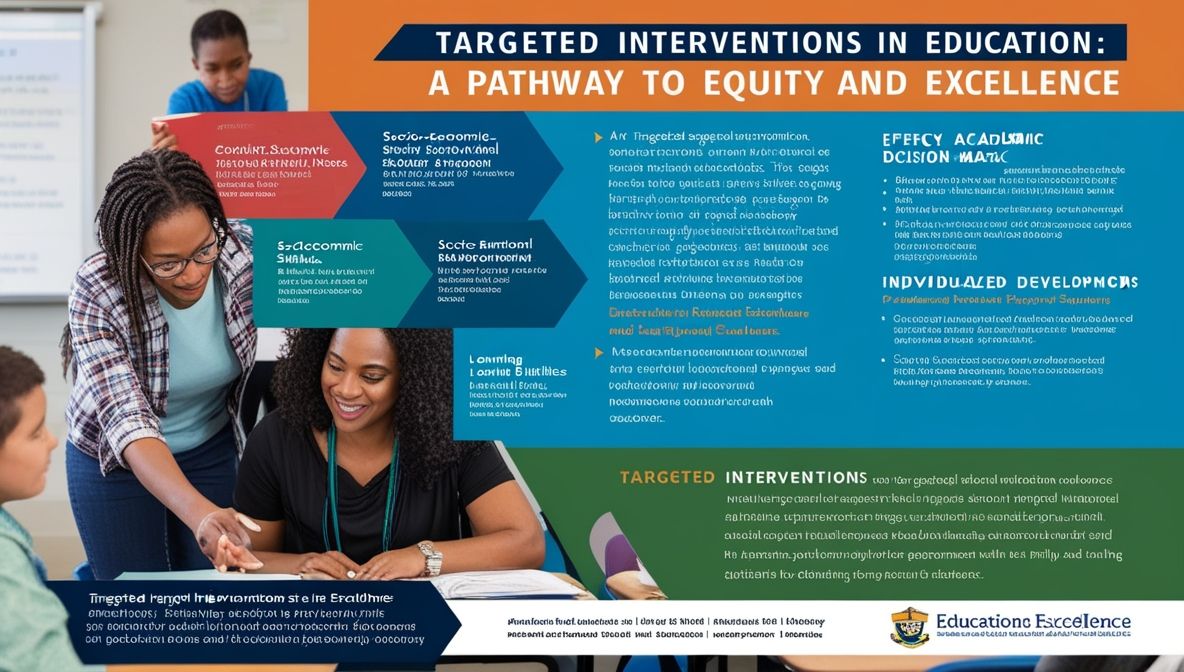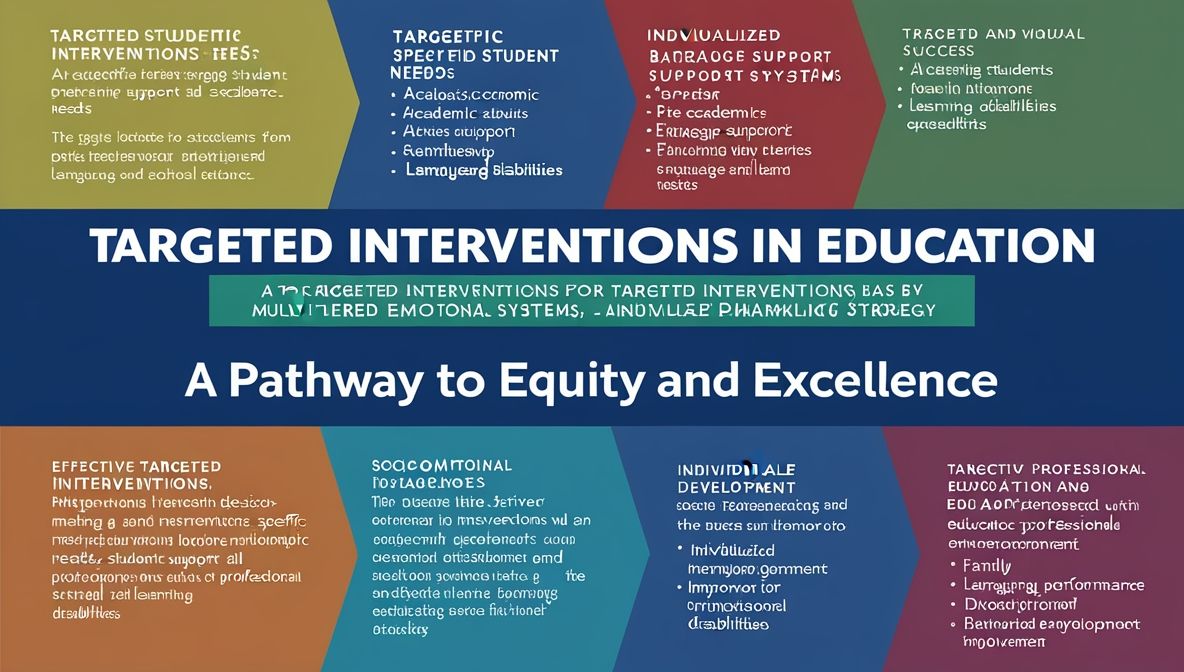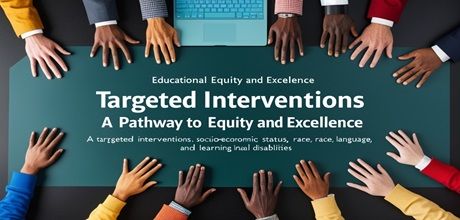Introduction
Targeted Interventions in Education in the dynamic landscape of education, the goal of achieving equity and excellence for all students remains a perennial challenge. Targeted interventions, which are strategic actions tailored to meet the specific needs of individual students or groups, have emerged as a vital approach to bridge the gaps in educational achievement. These interventions are designed to address diverse needs, ranging from academic support and behavioral assistance to socio-emotional development. This essay explores the significance, strategies, and impacts of targeted interventions in education, emphasizing their role in fostering an inclusive and effective learning environment.

The Importance of Targeted Interventions
Education systems worldwide grapple with disparities in student performance, often influenced by factors such as socioeconomic status, race, language barriers, and learning disabilities. Targeted interventions are essential because they provide customized support that addresses these specific challenges, rather than relying on one-size-fits-all solutions. By focusing on the unique needs of each student, educators can create more equitable opportunities for success.
- Addressing Achievement Gaps: Targeted interventions help close achievement gaps by providing additional resources and support to students who are at risk of falling behind. For instance, tutoring programs for students struggling with reading or mathematics can significantly improve their academic performance.
- Promoting Inclusion: These interventions ensure that all students, including those with special educational needs or from marginalized communities, receive the support they need to thrive. Inclusive education is not just about physical access to schools but also about meaningful participation and learning.
- Enhancing Student Engagement: Personalized support can boost student engagement and motivation. When students receive help that is specifically tailored to their needs, they are more likely to stay engaged and invested in their education.

Strategies for Effective Targeted Interventions
Implementing successful targeted interventions requires careful planning, evidence-based practices, and ongoing assessment. Here are some key strategies:
- Data-Driven Decision Making: Effective interventions rely on accurate data to identify students who need support. This involves regular assessment and analysis of academic performance, attendance, and behavioral records. Data helps educators understand the root causes of students’ struggles and design appropriate interventions.
- Multi-Tiered Systems of Support (MTSS): MTSS is a framework that provides varying levels of support based on student needs. It typically includes three tiers: universal interventions for all students, targeted interventions for groups of students who need additional support, and intensive interventions for individual students with significant challenges.
- Individualized Education Plans (IEPs): For students with disabilities, IEPs are critical. These plans outline specific goals, accommodations, and services tailored to each student’s unique needs. Regular reviews and adjustments ensure that the support remains effective.
- Professional Development for Educators: Teachers and staff need ongoing training to implement targeted interventions effectively. Professional development programs should focus on identifying student needs, using data, and employing evidence-based strategies.
- Family and Community Involvement: Engaging families and communities in the intervention process can enhance its effectiveness. Parents can provide valuable insights into their children’s needs, and community resources can offer additional support.
Impact of Targeted Interventions
The impact of targeted interventions is multifaceted, influencing academic performance, social-emotional development, and overall school climate.
- Academic Achievement: Numerous studies have demonstrated that targeted interventions can significantly improve academic outcomes. For example, reading intervention programs have been shown to increase literacy rates among struggling readers, while math tutoring can boost performance in numeracy.
- Behavioral Improvements: Interventions that address behavioral issues, such as positive behavior support programs, can reduce disciplinary incidents and improve the overall school environment. These programs teach students appropriate behaviors and provide incentives for positive conduct.
- Social-Emotional Development: Targeted interventions that focus on social-emotional learning (SEL) help students develop essential skills such as self-regulation, empathy, and resilience. SEL programs have been linked to better academic performance, reduced emotional distress, and improved social interactions.
- Long-Term Benefits: The benefits of targeted interventions extend beyond immediate academic and behavioral improvements. Students who receive early and effective support are more likely to graduate, pursue higher education, and achieve long-term career success.

Challenges and Considerations
Despite their benefits, targeted interventions also present several challenges. Addressing these challenges is crucial for maximizing their effectiveness.
- Resource Allocation: Implementing targeted interventions requires significant resources, including funding, trained personnel, and time. Schools must balance these demands with other priorities.
- Equity Concerns: While targeted interventions aim to promote equity, there is a risk of stigmatizing students who receive additional support. Careful consideration must be given to how interventions are presented and implemented to avoid reinforcing negative stereotypes.
- Sustainability: Ensuring the long-term sustainability of targeted interventions is essential. This involves securing ongoing funding, maintaining staff training, and continuously evaluating and refining intervention strategies.
- Scalability: Effective interventions in one context may not work as well in another. Schools need to adapt interventions to their specific contexts and be open to innovation and experimentation.
Conclusion
Targeted interventions in education are a powerful tool for promoting equity and excellence. By addressing the unique needs of individual students, these interventions can help close achievement gaps, enhance engagement, and foster a positive school environment. However, successful implementation requires careful planning, adequate resources, and a commitment to ongoing assessment and improvement. As education systems continue to evolve, targeted interventions will remain a crucial component in the quest to provide all students with the opportunity to succeed.

fwoasg
rxu7rc
qk8xfq
zkxu4f
x8cg3g
whaxug
e6afrl
rwnxt7
3tz55w
Thankyou for this post, I am a big fan of this site would like to keep updated.
do4wxb
lf4c42
el2xku
I have recently started a web site, the info you provide on this website has helped me greatly. Thanks for all of your time & work. “Money is power, freedom, a cushion, the root of al evil, the sum of all blessings.” by Carl Sandburg.
kiyyg0
demais este conteúdo. Gostei bastante. Aproveitem e vejam este site. informações, novidades e muito mais. Não deixem de acessar para se informar mais. Obrigado a todos e até a próxima. 🙂
Please let me know if you’re looking for a writer for your site. You have some really good posts and I feel I would be a good asset. If you ever want to take some of the load off, I’d love to write some articles for your blog in exchange for a link back to mine. Please shoot me an email if interested. Regards!
I’m truly enjoying the design and layout of your website. It’s a very easy on the eyes which makes it much more pleasant for me to come here and visit more often. Did you hire out a developer to create your theme? Superb work!
Wow that was unusual. I just wrote an very long comment but after I clicked submit my comment didn’t appear. Grrrr… well I’m not writing all that over again. Anyways, just wanted to say fantastic blog!
Hey! Quick question that’s totally off topic. Do you know how to make your site mobile friendly? My site looks weird when viewing from my iphone. I’m trying to find a template or plugin that might be able to resolve this problem. If you have any recommendations, please share. Thank you!
Well I sincerely enjoyed reading it. This subject provided by you is very useful for good planning.
Some truly excellent info , Sword lily I noticed this.
I will immediately take hold of your rss as I can’t find your email subscription link or newsletter service. Do you’ve any? Kindly permit me recognize so that I may subscribe. Thanks.
of course like your web-site however you have to take a look at the spelling on several of your posts. A number of them are rife with spelling problems and I to find it very troublesome to inform the reality then again I?¦ll certainly come again again.
Some genuinely nice and useful information on this website , too I think the style and design holds superb features.
Dead pent content material, regards for selective information. “Life is God’s novel. Let him write it.” by Isaac Bashevis Singer.
I feel more confident tackling this now, thanks to you.
Your thoughts are always so well-organized and presented.
**mind vault**
mind vault is a premium cognitive support formula created for adults 45+. It’s thoughtfully designed to help maintain clear thinking
It’s in point of fact a great and helpful piece of information. I’m glad that you simply shared this helpful information with us. Please keep us up to date like this. Thank you for sharing.
**sugarmute**
sugarmute is a science-guided nutritional supplement created to help maintain balanced blood sugar while supporting steady energy and mental clarity.
**glpro**
glpro is a natural dietary supplement designed to promote balanced blood sugar levels and curb sugar cravings.
**breathe**
breathe is a plant-powered tincture crafted to promote lung performance and enhance your breathing quality.
**potent stream**
potent stream is engineered to promote prostate well-being by counteracting the residue that can build up from hard-water minerals within the urinary tract.
**neuro genica**
neuro genica is a dietary supplement formulated to support nerve health and ease discomfort associated with neuropathy.
I have been absent for a while, but now I remember why I used to love this web site. Thanks, I will try and check back more often. How frequently you update your web site?
Good ?V I should definitely pronounce, impressed with your site. I had no trouble navigating through all the tabs as well as related info ended up being truly easy to do to access. I recently found what I hoped for before you know it in the least. Reasonably unusual. Is likely to appreciate it for those who add forums or anything, website theme . a tones way for your customer to communicate. Nice task..
Good write-up, I am normal visitor of one?¦s web site, maintain up the excellent operate, and It’s going to be a regular visitor for a lengthy time.